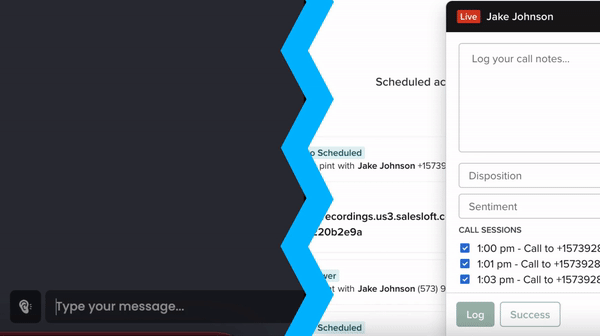What Is A Virtual Sales Floor?
Run Remote Call Blitzes That Don't Suck
Real-time and Scalable Coaching for Sales Teams That Dial


A big portion of companies have either gone fully remote or hybrid. In 2023, 12.7% of full-time employees worked remotely, and a staggering 28.2% were hybrid (Forbes). As this trend keeps growing, it is expected that 22% of the workforce in the US will be fully remote by 2025.
Although the remote and hybrid work models became highly popular during the COVID-19 pandemic, the trend stayed highly preferred by employees even after the pandemic was over, with 41% of the workforce preferring a hybrid model, and 32% a remote model in 2024, (Hubspot).
The shift from working in-office to work-from-home has changed the way teams work and collaborate, and the sales industry is no different. Although remote work has brought many benefits for companies and employees, sales is a very team-oriented job, and removing the benefits of an in-person sales floor can have great negative effects on the team’s productivity and performance.
Sales managers try to reduce these effects by bringing their team together even when they are in a remote setting, by introducing a virtual sales floor as a tool. Virtual sales floors are designed to replicate an in-person sales floor, allowing the team to be together in one place while calling, making live coaching possible, and allowing the manager to monitor and help their team.
Why Remote Work is Great
- Increased flexibility: Working remotely makes work life for employees much more flexible. Employees enjoy choosing when and where to work, the freedom to live wherever they choose, and the increased ability to tend to their family life. Also, a flexible working environment has been reported to help maintain a healthy and positive company culture (Techopedia, 2024).
- Employee satisfaction: As employees have more freedom around how to do their jobs, it has helped them keep a healthier work-life balance, which has, in turn, increased employee satisfaction.
In fact, 71% of remote employees stated that they find it easier to maintain a good work-life balance (Forbes, 2023), 63% of employees prioritize a good WLB over high pay (Hubspot, 2024), and 44% of job seekers are looking for a remote job (Techopedia, 2024). - Higher retention rates: All managers should take employee satisfaction into consideration, as it has direct effects on employee retention rates.
In addition to having flexibility and a better balance between work and life, employees have reported enjoying working remotely because of a multitude of benefits. Some of them include better savings due to not having to commute to work, increased mental and physical health, and feelings of being trusted by their employers and managers (US Career Institute, 2024).
Also, many workers experience less stress and many of them simply feel happier when working from home (Hubspot, 2024). Offering remote work options to employees could help managers increase their employees’ satisfaction and happiness levels to decrease turnover. - Higher productivity: According to multiple sources, working from home has increased employee productivity and performance.
To be more specific, 79% of managers say that their team has been more productive when remote (Statista, 2024). Not only can this be attributed to the increased employee satisfaction that working from home has brought, but also to the fact that employees find working from home easier, as they have fewer distractions and better focus (Hubspot, 2024). - Bigger talent pool: The talent pool companies have access to when looking to make new hires is way bigger when looking for remote employees (Techopedia, 2024). Being able to hire people from all geographical locations has widened managers’ access to people who are more qualified and with more experience.
- Reduced costs for companies: In addition to having more employee satisfaction, higher retention rates, and increased performance, the remote work model can offer direct financial benefits to companies.
When companies operate fully in a remote setting, they won’t have all the costs that come with having an office. In 2023, companies could save annually up to $11.000 per employee in overhead expenses and utilities (Forbes).

The Problems with Remote Work
- Reduced employee collaboration: Not only have remote employees reported feelings of loneliness and isolation, but companies have also noticed a decrease in team collaboration and communication (Hubspot, 2024). In fact, 53% of remote employees find it more difficult to connect with their colleagues (Forbes, 2023).
- Higher risk of burnout: Communicating with your team and different departments has become more complicated with remote work, as many companies use multiple different communication tools, leading to higher mental fatigue and burnout (Forbes, 2023).
Also, although employees find that they have more time for personal life when working remotely, the boundary between work and personal life could be clearer. Many workers check their email and messages even after work hours, finding it more difficult to unplug (Hubspot, 2024). - Challenges for management: Not being able to be with your team physically can make many aspects of managing more challenging.
Maintaining a team-oriented culture can be hard due to the decreased communication between coworkers. When working in person, managers can make sure that their team has opportunities to connect, have fun, and have healthy competition between themselves. Keeping up such a culture when all of the employees work from home can be challenging.
Also, onboarding new employees is more confusing, and training them can be way slower (US Career Institute, 2024), and therefore even more costly. Teaching newcomers how to use all the tools and how to do their jobs can be way more complicated, and they might have to do a big portion of the learning on their own.
Finally, tracking employee performance and giving recognition to top performers is not as prevalent in remote companies (Techopedia, 2024).
Disadvantages for Sales Teams
Although all the benefits that come with remote work also apply to remote sales teams, there are some disadvantages that come specifically when SDRs work from home.
Sales is very team-oriented. A big part of an SDR’s evolution happens when they are able to listen to their coworkers’ calls, see how they are handling any objections and how they are pitching, share information with their team, and analyze everyone’s calls. This important part of sales has become more difficult with remote work.
Also, cold-calling is a very difficult job. Calling prospects again and again and just getting rejected all day can become very hard to endure if done alone. In-person, reps are able to uplift each other, celebrate wins together, laugh, and learn from their losses and rejections, and they are able to have a much healthier cold-calling culture than when remote.
Finally, as a manager, coaching and training your reps and onboarding newcomers requires you to be able to listen to your reps’ calls, give them real-time feedback, hype them up when you notice that they are feeling nervous and not as confident, and be there for them when they need you. All of this becomes more challenging when the “in-person” part is taken away, and your whole team is working in isolation.
What is a Virtual Sales Floor
One way sales managers started bringing their team in one place to cold call, was by using video conferencing tools, such as MS Teams, Zoom, Google Meets, and so on. Although these platforms are a great way to reduce isolation and build team collaboration and unity, they do not work as well when reps are cold-calling together.
The technology is not built for a sales team, and so there are many operational issues. These tools do not integrate with dialers, and reps have to mute and unmute themselves constantly in order to avoid distracting others while they are making calls. Also, managers are only able to listen to one call at a time, and even that requires the rep to have their call on speakerphone so that it can be heard on the other end of the meeting.
Another, more efficient way to bring a remote team together is by using a virtual sales floor. A virtual sales floor is a platform that uses video conferencing technology but is specifically built for cold-calling, to allow reps to work and collaborate in a remote setting, just as they would in person.
The goal of these platforms is to fix some of the key issues that sales managers are experiencing around the lack of team communication and collaboration, as well as around the struggles of managing and coaching efficiently.
There are two main types of virtual sales floors. Dialers with a sales floor feature and sales floors that integrate with your already existing dialer. Both come with different benefits.
- Dialers with a sales floor feature: These dialers have a sales floor feature, and usually also a CRM, and they are useful as all of a rep’s workflow can be done in one place, saving up time. However, it might take some time for a sales team to adopt these tools because they have a bigger learning curve, and tend to be on the more expensive side.
- A virtual sales floor that integrates with your dialer: In this case, a sales floor integrates with a team’s already existing dialer. It is a cost-effective way to bring your team together, and the changes in a rep’s workflow are minimal which makes it easily adaptable.
Features and Benefits of a Virtual Sales Floor
As mentioned before, the goal of a virtual sales floor is to tackle some of the issues that working remotely has brought to sales teams, and to bring in the benefits that an in-person team would have.

1. The team is in one place
In the same way that a sales team works together in one office, a virtual sales floor allows the whole team to be together remotely.
Reps are able to see and talk to each other live and they can be calling prospects simultaneously. The team gets to collaborate and work together, having a sense of community and togetherness, as opposed to the feelings of isolation remote work can bring.
Also, being able to work together and hear each other handling calls encourages reps to learn from each other things, such as objection handling and pitching, and it makes onboarding new reps way easier and faster.
At the end of the day, sales is a team sport, and having the ability to work alongside your colleagues, learn from each other, have fun together, celebrate each other’s wins, and laugh lightheartedly with each other’s mistakes, builds up a fun and motivating team culture which also leads to higher productivity.

2. Live coaching
When you work from an office, you are able to listen to your reps while they are on a call and you can give them live tips, guidance, and immediate feedback after their calls, which is crucial for their learning process.
Think about a soccer coach with their team. They spend a lot of time talking theory, coming up with game plans, and practicing, but the real thing happens during their games. If the coach is not there during the actual game, then they are not coaching properly.
Although practicing and watching post-game tapes to evaluate the team’s performance are important parts of coaching, It is during the game that the soccer coach will be able to adjust the team’s plan and strategy according to their opponent’s moves, and it is only then when they are able to fully evaluate the players’ performance.

It is the same way in sales. Your team needs you on the field with them. You can spend as much time doing mock calls, listening to call recordings, and talking about how sales work, but the real learning happens when your reps are actually cold-calling. That is when they need you by their side, giving them feedback, encouraging them, and guiding them.
Many remote sales managers rely on call recordings to evaluate their rep’s performance and to give them coaching. The issue is that call recordings are not efficient. The feedback you are giving might not be relevant anymore. By the time you get the recording, have the time to review it, and send your notes to your rep, that specific call is old news.
Virtual sales floors allow you to listen to your team’s calls live and you can either whisper in their ear while they are on the call, as you would in an actual office, or you can use a chat box to coach them live. This way the rep can correct any mistakes immediately, they can get confirmation around what they are doing right, and they can feel more supported while doing the scary task of cold-calling.

3. Performance dashboard
Many sales offices usually have a whiteboard of sorts, where the team can track the number of calls made, most meetings booked, and so on. Being able to see these statistics helps reps feel more motivated to perform and it encourages healthy competition.
Virtual sales floors often allow reps to track each other’s performance live, and reps can compare and have the same sense of competition remotely. This also motivates the team to celebrate each other’s successes and build camaraderie.

4. The manager is present
When reps work remotely, their manager is not able to actually see what they are doing. Being able to see your reps' work, hear them on the calls, see their body language, and be there for them so that they can come to you, are crucial factors you need to be able to actually manage your team.
With a virtual sales floor, you can join your team when they are making calls, make yourself available so that they can come to you with any questions or concerns, and even lead by example and start cold-calling with them. Building a good and healthy relationship with your team is easier if you are able to see them and talk to them live.

Disadvantages of a Virtual Sales Floor
Although virtual sales floors tackle many issues that remote sales teams have been struggling with, they do not offer solutions to all the disadvantages of remote work.
Sales managers need to take into consideration that, although reps get to do call blocks together, a lot of the other work that comes with sales, such as prospecting and doing other types of cold outreach, is still done in isolation. It is important that you make yourself available and that you support your reps in all aspects of the job.
Also, a virtual sales floor cannot fully replace the in-person experience. Reps might learn faster than they would without the platform, but being able to communicate with coworkers in person brings another level of unity, relatability, fun, and excitement to work. It is way easier for them to build actual friendships, to share information, and to support each other as a community.
Finally, a virtual sales floor might help reps draw a clearer line between work hours and leisure time, but it does not help with the increased chances of burnout due to workers checking their work emails during personal time.
The Remote Work Culture is Here to Stay
Whether we like it or not, the remote and hybrid work models are here to stay, and if you are looking to grow your company you might want to consider offering some work-from-home benefits.
Although remote work comes with some great advantages that we ought to take into consideration, such as happier and more motivated employees, better team performance, access to a larger talent pool, and reduced costs for companies, it is important not to overlook some of the disadvantages, especially for sales teams.
Reduced team collaboration, lack of live coaching, weakened team culture, and the difficulties sales managers face in actually being there for their team, are a few of the disadvantages that come with the remote world.
Thankfully, virtual sales floors were built to make those issues less prevalent for sales teams, as these platforms bring reps to cold-call, learn, and win together, in one place. Managers can coach, train, and onboard reps with less difficulty, and the team can have fun and build culture together.
Ready to make your reps fall in love with the phone?
Build a real cold-calling culture on the CallBlitz virtual salesfloor



